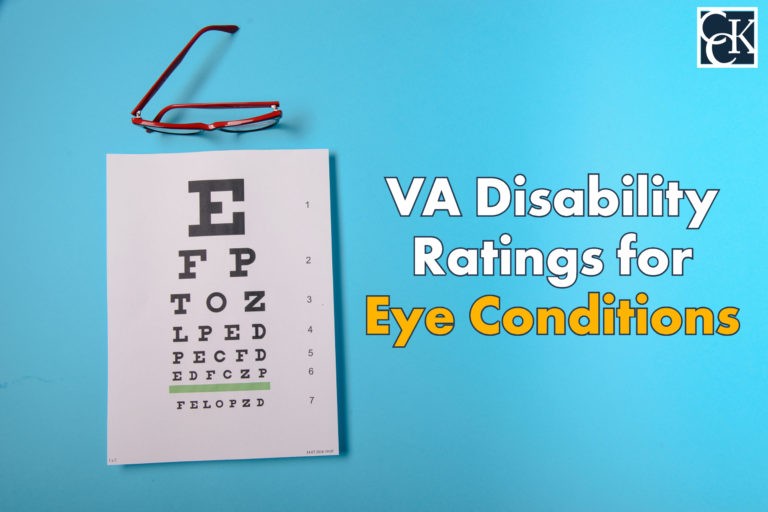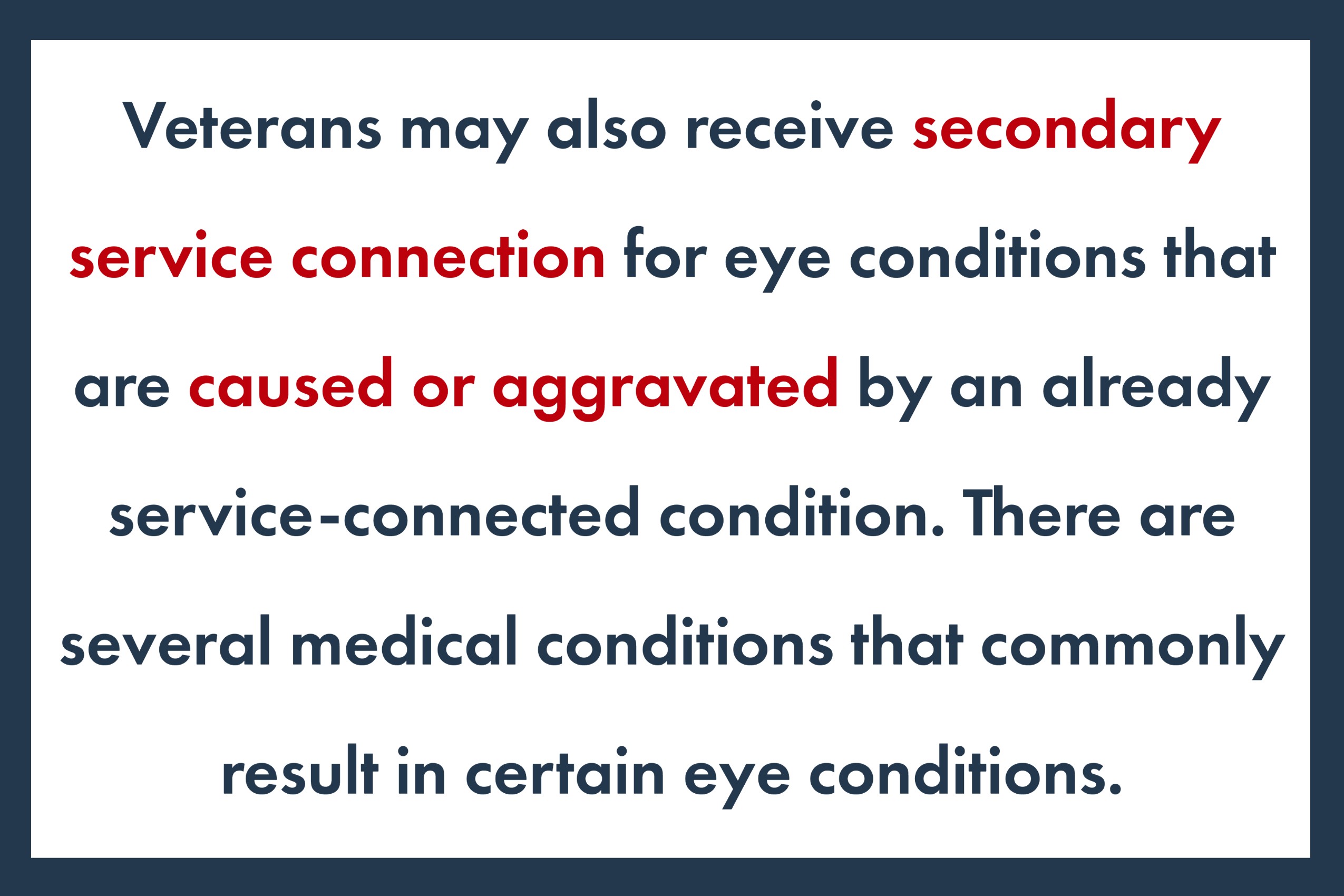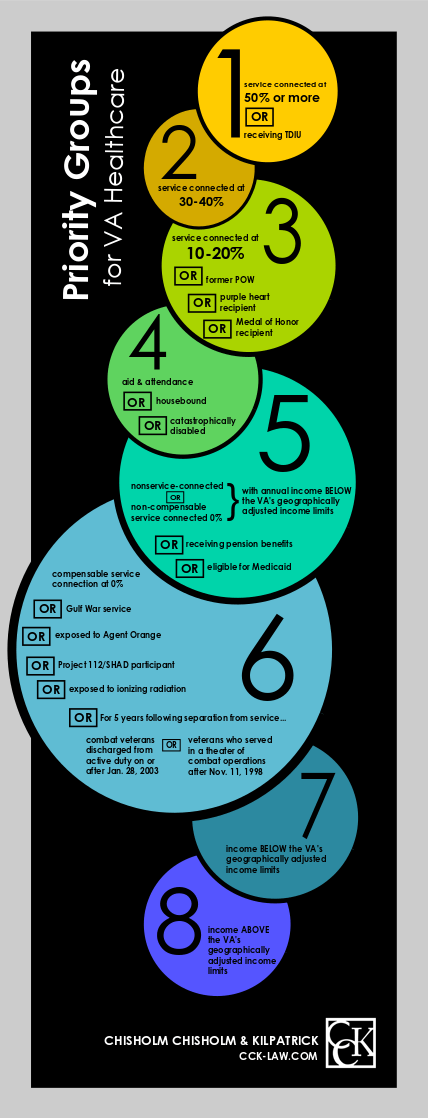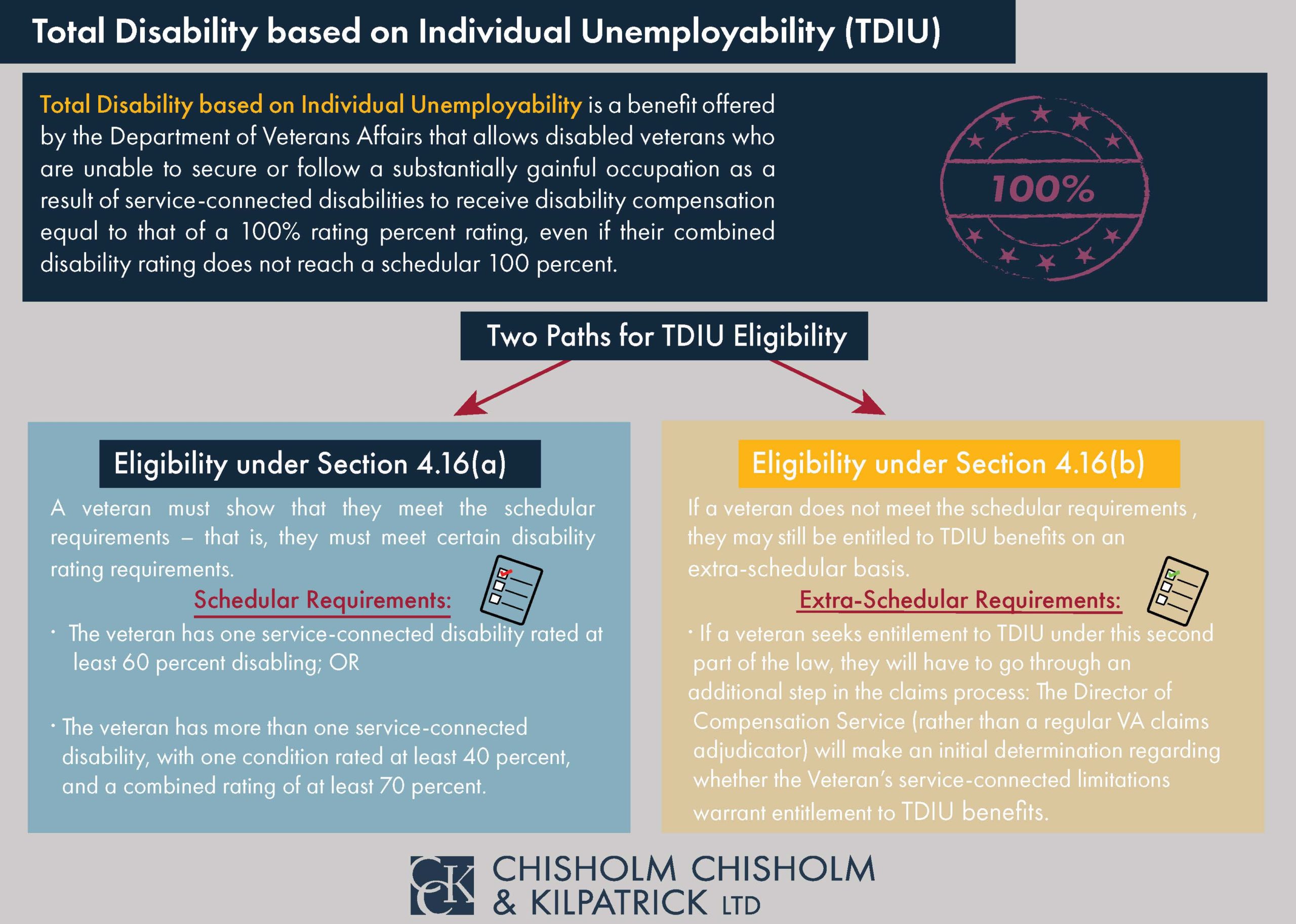VA Disability Benefits for Eye Conditions

CCK Law: Our Vital Role in Veterans Law
As of 2019, roughly 315,000 veterans are receiving VA disability compensation for eye conditions resulting from their time in military service. The most prominent eye condition in which veterans are service-connected for blindness is one or both eyes. Of the veterans who are service-connected for eye conditions, about one-third of them are Gulf War Veterans.
Eye conditions may result from injuries, damage from exposures, and/or illnesses contracted while in service. Eye conditions may also arise as secondary conditions, meaning that they were caused or aggravated by another condition. For some veterans, VA does offer vision care benefits, which can cover the cost of eyeglasses and other vision care.
Common Eye Conditions Rated by VA
The VA Schedule of Rating Disabilities (VASRD) is broken down into 15 body systems, each of which is comprised of various diseases and conditions.
VA disability ratings for eye conditions are generally rated under 38 CFR § 4.79, Schedule of Ratings – Eye, Diagnostic Codes 6000 to 6091. Some of the most common visual impairments for which veterans receive disability compensation include the following:
- Blurry vision
- Double vision
- Loss of sight
- Loss of peripheral vision
- Loss of light perception
- Loss of the eye or both eyes
- Loss of the eyelids, eyelashes, or eyebrows,
- Ptosis of either or both eyes
- Conjunctivitis related conditions
- Inflammatory eye conditions
- Glaucoma
- Cataracts and lens conditions
- Retinal conditions
In 2018, VA made revisions to the general rating formula for diseases of the eye to include the following as well: diabetic retinopathy, retinal dystrophy, and post-chiasmal disorders. Importantly, no eye conditions were removed from the rating schedule.
Service Connection for Eye Conditions
There is more than one way for veterans to receive VA service connection for eye conditions.
Direct Service Connection for an Eye Condition
To qualify for VA disability benefits for eye conditions, veterans must establish service connection. To prove direct service connection, veterans must demonstrate the following:
- A current diagnosis of an eye condition;
- An in-service event, injury, or illness related to the eye condition; and
- A medical nexus opinion linking the current eye condition to the in-service event, injury, or illness
Once direct service connection is established, VA will assign a disability rating (see below). However, direct service connection is not the only form of service connection that can be established for eye conditions.
Secondary Service Connection for Eye Conditions
Veterans may also receive secondary service connection for eye conditions that are caused or aggravated by an already service-connected condition. There are several medical conditions that commonly result in certain eye conditions, including the following:
- Diabetes mellitus may result in diabetic retinopathy, glaucoma, and cataracts
- Sarcoidosis may result in optical neuropathy
- Lyme Disease may result in retinal vasculitis and optic disc edema
- Cerebrovascular accidents (stroke) may result in blind spots or vision loss
- Thyroid problems may result in double or blurred vision
- Multiple sclerosis may result in changes in vision, optic neuritis, and/or gradual vision loss
- Rheumatoid arthritis may result in thinning of the cornea
Importantly, if veterans are taking medication for a service-connected condition that causes vision problems, they may be eligible for service connection on a secondary basis for that resulting eye condition. Common examples of this include the following*:
- Hydroxychloroquine – used to treat lupus and rheumatoid arthritis; can cause ocular toxicity and problems with the corneas
- Medications for depression, Parkinson’s disease, seizures, ulcers, asthma, and hemorrhoids – linked to glaucoma
- Bisphosphonates – for bone loss; linked to orbital inflammation, uveitis, and scleritis
- Erectile dysfunction medications – linked to ischemic optic neuropathy
- Blood pressure medications – linked to worsening glaucoma
- Parkinson’s disease medications – linked to worsening eye problems
- Traumatic brain injury (TBI) – veterans who suffer a TBI in service may also experience eye conditions, such as blurred vision, double vision, and loss of sight
*Note: The information included above was taken from the October 2011 edition of “Review of Ophthalmology”
If veterans are service-connected for any of the above-mentioned conditions and take the listed medications, they should be aware of the onset and progression of eye conditions. Furthermore, they should be aware that VA disability benefits may be available should any of those eye conditions present.

How VA Rates Eye Conditions
VA rates eye conditions based on three main measurements: (1) central visual acuity; (2) visual field; and (3) muscle function.
Central Visual Acuity
Central visual acuity refers to the ability to distinguish shapes and details of objects at a given distance. Specifically, it
pertains to how focused or blurry an image is when looking at it from specific distances. “Near-sighted” and “far-sighted” are both terms that describe central visual acuity.
VA usually tests central visual acuity using a basic eye chart examination. The measurements range from 20/20 to 5/200 and VA then assigns an evaluation based on the veteran’s corrected distant vision (if it can be corrected). This means that no matter how bad the veteran’s vision is without glasses or contacts, they will only be rated on how good the vision is with glasses or contacts.
If a veteran’s vision is worse than 5/200, they are considered to be blind. Importantly, VA rates both eyes together, meaning veterans will receive one combined rating that accounts for both impairments.
Visual Field
Visual field refers to the entire range of vision that can be seen when looking at a fixed point straight ahead. Visual field testing is performed using several different automatic tests that measure the range of vision of each eye without moving the eyeball.
Most often, eye exams have a chart included with 16 meridians for each eye moving outward from the center; however, only eight directions are used for rating: upward, downward, nasally (toward the nose), temporally (away from the nose), and once midway between each of these. The normal visual field is as follows:
- 65 degrees down
- 50 degrees down nasally
- 60 degrees nasally
- 55 degrees up nasally
- 45 degrees up
- 55 degrees up temporally
- 85 degrees temporally; and
- 85 degrees down temporally
The total normal visual field equals 500 degrees. When the visual field does not match up to these measurements, a disability evaluation will be assigned depending on the extent of the vision loss.
Muscle Dysfunction
Muscle dysfunction involves how well the muscles of the eye move and is measured on the same type of chart as the visual field. To measure the decrease in muscle function, the visual chart is divided into four quadrants: up, down, nasally, and temporally. Muscle dysfunction can exist in one or both eyes, but again, veterans will only receive one disability rating.
After all three of these main measurements have been obtained, VA will rate the eye condition using scales that combine all three measurements for both eyes. It is important to note that only an optometrist or ophthalmologist is considered qualified to make these measurements. This will likely occur at a Compensation & Pension examination.
If veterans are not satisfied with the optometrist’s findings, it may be beneficial to submit an argument to VA explaining why.
Diseases of the Eye VA Ratings
Diseases of the eye are rated under 38 CFR § 4.79 with varying percentages for increased severity. Percentages are assigned based on the level of visual impairment due to the condition, or incapacitating episodes caused by the condition. Below are the criteria for each percentage rating:
- 10% — For diseases of the eye with documented incapacitating episodes requiring at least 1 but less than 3 treatment visits for an eye condition during the past 12 months
- 20% — For diseases of the eye with documented incapacitating episodes requiring at least 3 but less than 5 treatment visits for an eye condition during the past 12 months
- 40% — For diseases of the eye with documented incapacitating episodes requiring at least 5 but less than 7 treatment visits for an eye condition during the past 12 months
- 60% — For diseases of the eye with documented incapacitating episodes requiring at 7 or more treatment visits for an eye condition during the past 12 months
Tips for C&P Exams for Eye Conditions
Veterans should keep in mind that a Compensation & Pension (C&P) examination will be required in order to determine service connection and receive a VA disability rating. Importantly, only an optometrist or ophthalmologist is qualified to take the measurements outlined above.
If a C&P exam for eye conditions is being conducted by someone who is not an optometrist or ophthalmologist, veterans should notify VA immediately. In this case, VA should deem the C&P examination inadequate for rating purposes. Again, all other medical professionals lack the qualifications necessary to conduct proper eye examinations.
VA Special Monthly Compensation (SMC) for Eye Conditions
Special Monthly Compensation (SMC) is awarded to veterans with a service-connected condition, or combination of service-connected conditions, considered by VA to be especially serious and debilitating. The severity of these conditions warrants higher rates of compensation above the schedular 100 percent. Technically, veterans do not need to apply for SMC, as VA should automatically award it to them during the claims process if they qualify. However, it is recommended that veterans specifically raise the issue of SMC during the claims process.
There are numerous levels of SMC benefits depending on the nature of the disability, and the amount of compensation varies for each type. The most common level of SMC that veterans receive for eye conditions is the first level, SMC(k).
Importantly, SMC(k) is the only level of SMC in which the compensation amount is added to the veteran’s regular monthly compensation rate. SMC(k) is payable for blindness of one eye whose functionality is only light perception. If a veteran is blind in both eyes, they may be eligible for a higher level of SMC.
VA Healthcare and Eye Conditions
If veterans qualify for VA healthcare benefits, they may also be able to get some or all of their vision care through VA. For example, VA will cover routine eye exams and preventive vision testing, such as testing for glaucoma. In order to cover the cost of a veteran’s eyeglasses, at least one of the following must be true:
- Have a compensable service-connected disability; or
- Are a former prisoner of war; or
- Were awarded a Purple Heart; or
- Receive benefits under 38 USC § 1151; or
- Received an increased pension based on your being permanently housebound and in need of regular aid and attendance
VA will also cover the cost of a veteran’s eyeglasses if they have certain health conditions. To learn more about VA vision care, talk to your VA primary care provider, contact your nearest VA medical center or clinic, or check VA’s Vision Care page.
Tips for Eye Condition VA Claims
Overall, veterans should provide as much information as possible to VA as it pertains to their eye conditions. Again, C&P examinations are a very integral part of the claims process, and so attendance and honest participation are necessary. Veterans should also request copies of their C&P examinations to ensure that the information is thorough and accurate, and that the person conducting the exam is properly accredited.
In addition, it is very difficult to obtain a 100 percent schedular disability rating for eye conditions. Therefore, if a veteran is unable to work due to their eye condition, they should consider applying for total disability based on individual unemployability (TDIU). This benefit may offer an alternative path to the highest amount of disability compensation.
Was Your VA Claim Based on an Eye Condition Denied?
The experienced, accredited attorneys and advocates at Chisholm Chisholm & Kilpatrick LTD have decades of experience successfully representing veterans and their families before VA, the Court of Appeals for Veterans Claims, and the Federal Circuit. We may be able to help you. Contact us at 800-544-9144 for a free consultation.
About the Author
Share this Post



